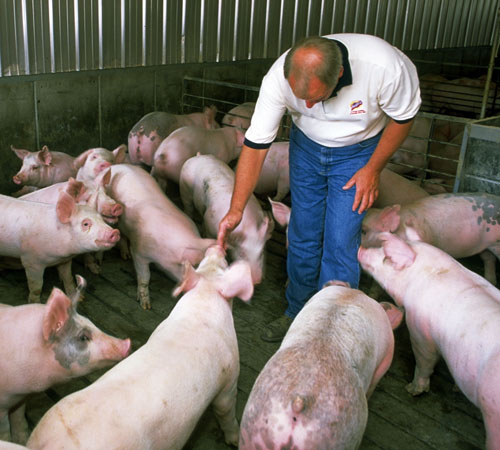In the pigpen: UI swine researchers don’t mind a little dirt

February 16, 2009
In some respects, pigs are comparable to grandma’s homemade cookies since you can almost always smell them before you see them. However, unlike a plate of scrumptious snickerdoodles, most people hesitate before diving into a pigpen.
Bill Fisher, manager of the general swine farm at the University, said he sees no reason for hesitation. Before most students are even awake, Fisher is out on the farm greeting each pig in the morning.
“I like to say we shake hands with every pig,” Fisher said. “We look them in the eye and make sure they’re up, eating, and feeling good.”
As a caretaker, Fisher, along with a team of full-time workers and part-time students, works closely with the veterinary school in order to keep the herd as healthy as possible.
“There are a few diseases that can be transferred to the pigs, such as salmonella and the influenza virus,” Fisher said.
Get The Daily Illini in your inbox!
Nobody wants to see what an achy, feverish, 800 pound boar with the chills might look like. For these reasons, Fisher exercises a very strict policy regarding who can be exposed to the herd.
Some students remain unaware that these livestock research farms even exist.
“I didn’t know the University had their own pigs until a southern breeze enlightened me,” said Erika Lans, junior in Media.
The swine farm has been home to thousands of pigs for the past 40 years, with the normal inventory consisting of about 1,800 pigs per year.
Presently, Fisher said the farm is in a very unique situation because the research center is depopulating for the first time.
“Depopulating basically means marketing the animals that are on the farm now and buying in new breeding stock to build the herd back up in January,” he said.
Clearing out the old breeding stock eliminates any possible problematic diseases that might have been embedded in the genetic system over a long period of time, Fisher added.
When the farm is repopulated later in the year, it will take a scientific approach in order to determine which types of pigs to breed.
“The pork industry has come to the great realization that we just aren’t pig farmers anymore,” Fisher added. “It’s a very science-oriented field because we are producing protein for the American diet and for the world.”
He said that 26 percent of U.S. pork is exported to other countries, with exports to Russia increasing by 168 percent this past year alone.
Generally, the new breeding stock starts with females who show superior mothering abilities. Males are selected for their growth, efficiency to convert feed to pork, and for their meat quality.
“These hybrid pigs give farmers the maximum edge in efficiency and production of pork,” Fisher said.
All of the swine on the research farm represent the combined genetics of Yorkshire, Landrance, and Duroc breeds to produce predominantly large, white pigs, Fisher added.
However, in 1988 the University imported Meishan pigs from China to use as a genetic cross to improve pig production. Fisher said this particular breed of pig had been shown to produce litters in the 25 to 30 range. From studying these pigs, researchers were able to develop a method of creating more prolific lines, which proved successful.
“Investigative science always has some serendipitous results,” Fisher said.
When pigs are born they only weigh about three pounds. They stay on their mother’s milk for 21 days, in which they increase their weight by five fold. They are then weaned from the milk and transferred to a fortified dry feed while they continue to grow in a nursery for six weeks.
Fisher added that the University pioneered early weaning diets. Historically, pigs were not weaned until they were nine weeks old. Today, Fisher can wean a pig in as little as fourteen days.
The swine then spend another sixteen weeks growing to about 260 pounds before they are “harvested,” according to Fisher. Each pig will eat ten bushels of corn and 250 pounds of soybean meal in the six months they are on the farm.
“They convert approximately three pounds of feed to one pound of pork,” he said.
In fact, nutrition is the primary focus of Fisher’s researchers right now.
“It’s important for us to learn what levels of Distillers Dried Grains to use and how to use them,” he said.
Distillers Dried Grains are a type of livestock feed as well as a by-product of ethanol that has become widely available with the increase in ethanol production.
Of the pigs that go through the farm, 95 percent will go into the food chain. The exceptions, Fisher said, are those pigs that were fed special diets or given certain medications.
“We have to be very careful about it,” he said.
He added that anyone who works in the industry has to be certified by the National Pork Board every three years to ensure that the pigs that are harvested produce quality meat and that the animals are well cared for.
Jim Kaitschuk, executive director of the Illinois Pork Producers Association in Springfield, said the association works to promote pork as a general template and works as an advocate for pork producers.
“We’re always involved with the University in different areas of research,” Kaitschuk said. “However, our focal point is to represent the interests of the producers.”
Because pork producers have to be very concerned with meat quality today, the research surrounding the industry has changed significantly in the past 25 years.
“The Meat Sciences Laboratories give us the opportunity to do in-depth scientific examinations of the meat we produce,” Fisher said. “At one time we just looked at the results of how a feed ingredient changed the growth of that animal, then we started looking at how it changed the complexity of the meat it produced, and today we go to taste panels.”






